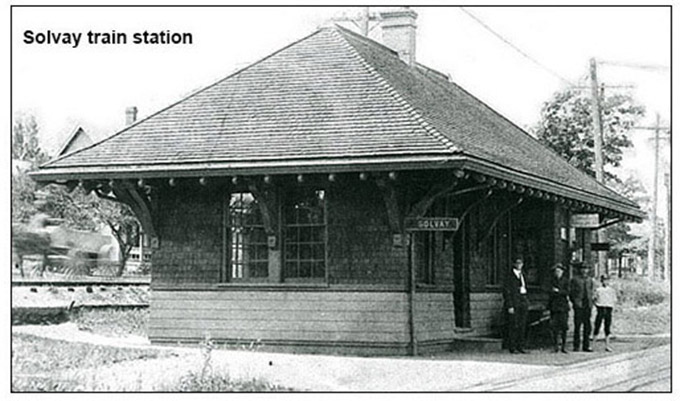 |
No tickets sold, but station stays open
What had been threatened the year before came true in January with the announcement from Albany that New York Central was authorized to discontinue the services of a ticket agent at its Solvay station. That agent was Solvay mayor Charles R. Hall.
Whether Hall was completely out of work wasn't made clear because, while tickets no longer would be sold there, the station itself would remain open. The public service commission ordered New York Central to keep the station clean, lighted and heated during the same hours it had previously, and that all passenger trains that stopped at the station before the ruling wound continue to stop there. |
Community A. C. building damaged
Fire swept the Solvay Community Athletic Club on the second floor of the two-story building at 1747 Milton Avenue on January 21, causing damage estimated at several hundred dollars.
Eight days later fire caused damage estimated at $15,000 at 300 Charles Avenue, Solvay. The blaze was discovered at 1 a.m. by a passerby; when Solvay firemen reached the scene, all of the windows in the two-story block building blew out. Pieces of glass were hurled across the street.
Don Tenesi of 404 Prospect Avenue, Syracuse, is the owner of the building and of a store on the first floor. The Tenesi store handles Italian imports and its shelves were laden with olive oil and a valuable stock of delicacies, included imported macaroni. |
Chamberlain, Valletta and Cottrell
are winners in village election
In the March 15 village election, Democrat Edward S. Chamberlain beat Republican James Hennessey by 198 votes for trustee in the First Wards, and Republican Louis Valletta beat Democrat Ronald Blair by 168 votes for trustee in the Second Ward. James Cottrell, a Democrat trustee, was unopposed in the Third Ward.
A month later Solvay followed the example set by Syracuse Wednesday when a new municipal retrenchment policy — including a 10 percent salary cut for all employees — went into effect.
The problem of paying the police force was solved when the four patrolmen — Clyde Salisbury, John Brown, John Murphy and Peter Dadey — agreed to go on a half-time basis after May 1. The board had intended dropping two of them, but accepted the plan advanced by the men and will keep them all on the roster. |
Syracuse Journal, July 21
Solvay hosts firemen's convention
While the sun was shooting the mercury up to the 87 degree mark and a crowd of 1,500 people stood wilting under its rays, the East Syracuse department defeated the Solvay team in the championship water fight as the feature event on the closing program of the 34th annual meeting of the Onondaga County Volunteer Firemen’s Association at Solvay yesterday afternoon.
It took the East Syracuse team but four and one-half minutes to capture the coveted title trophy and award of $75. The losers were trying to win with a hose nozzle that remained stuck half-open.
The final day’s program got underway at 10 a.m. with a parade of 10 bands and apparatus through the streets of Solvay. The judges decided Hinsdale had the best appearing women’s auxiliary in line. Other parade prizes went to Margaret O’Neill of Solvay, tallest woman; Dorothy Kurtz of Solvay, shortest woman, and Elizabeth Kinsella of Solvay, best looking.
Andrew Spence of Tully, shortest man in line; John W. Fleegal of East Syracuse Exempt firemen, tallest, and East Syracuse, company having the most men marching. The title for the best looking man in line resulted in a draw for the decision. G. E. Ferguson of North Syracuse and Don Williams of East Syracuse were the winners. |
|
Syracuse American, November 6
Woods Road "pirates" are sunk
A sizable segment of Solvay was encamped in children’s court yesterday morning when Judge William L. Barnum mounted the bench to sit in judgment over seven scared little “Pirates of Woods Road,” rounded up in a weekend haul of the law’s dragnet by deputy sheriffs and Solvay police.
Every one of the seven was flanked by a supporting group consisting of papa and mama, with two or three aunts and uncles and a few sympathetic neighbors. The chattering — very little of it in English — sounded like the tumult at the Tower of Babel to uncomprehending ears. There was waving of arms, brandishing of fists and women’s tears, and it took deputy sheriffs and court attendants some time to get things calmed down to meet the demands of judicial decorum.
As summarized by Mrs. Mary F. Tormey, deputy sheriff, the situation seemed to be about like this:
The “pirates,” who selected their own name for what otherwise would be just an ordinary neighborhood gang, have been taking advantage of parental laxity to run wild in the Solvay streets this fall.
Nightly, in bands of four to 10, they have been centering their attention of cars parked in Milton Avenue, Woods Road or adjacent streets. When the cars were unlocked, they dived in and removed everything of value, include some accessories. When the cars were locked, they smashed windows and accomplished the same thing. It was naturally quite annoying to owners of the cars.
After the Solvay police had rounded up a few suspects and hauled them before Judge Ambrose Ginnelly, only to find that the law demands unassailable evidence, they called in Mrs. Tormey and a couple of masculine deputies. Careful investigation led to the belief that 11 youths — none over the age of 15 — were involved, and surprise raids on the homes of a few of them revealed a large part of the loot.
It included everything from $200 electrical motors to flashlights, robes and overcoats, and by the time the deputies were through collecting, they had almost a truckload of the stuff. In all cases, of course, the parents were vastly surprised to find that their offspring had something that had been stolen, and in some of the homes, the young prisoners were taken to the woodshed and put in a chastened frame of mind before being turned over to the law.
Judge Barnum lined the seven culprits up before him yesterday, with their noses barely clearing the desk, and read the warrants in a stern voice. Seven times piping voices answered “Guilty” to his demand for a plea. And seven heads hung as he asked for explanation. When none was forthcoming, he announced:
“I’ll commit them all to the juvenile detention home for one week while we think the case over.”
The weeping became almost hysterical as the deputies led the group away, and many of the worried mothers were comforted only when Mrs. Tormey wrote out cards showing them where their offspring were headed and how to visit them. |
|
The losing battle continued . . .
On June 24 federal agents followed their noses to a garage at 236 Charles Avenue, Solvay, and found three 400-gallon stills. They visited the neighborhood and detected the familiar odor of mash, and made the raid without a warrant. They arrested two men who gave the names Diovani Pebedegolviki* and Charles Chemalik.
* "Diovani Pebedegolviki" is quite a mouthful. I could find no such name anywhere else, although there was a Dionzio Pedregalli living in Solvay at the time, as well as a Dionigio Pederzolli. Maybe the man arrested made up the name . . . or a compositor at the Journal sneezed when set the name in type.
On November 10, agents raided two places in Solvay. At 2263 Milton Avenue they seize seven barrels of beer and a small amount of spirits and arrested Stan J. Barnell on the charge of possession. Eugene Fallonin was arrested at 108 Lamont Avenue and charged with possession of a small quantity of white distilled spirits.
A week later, Elizabeth Piotnowski was arrested again at 118 Woods Road, after agents found six half barrels of beer, a pint of colored spirits and a pint of white spirits. Previously agents had admitted that although Ms. Piotnowski's homemade beer was illegal, it was very good
The same day — and the day after that — agents raided places at First Street and Cogswell avenue. Joseph Sarbelan was arrested November 18 after agents found a gallon of wine. No arrests were made the next day when agents found a half-barrel of beer across the street.
|
Syracuse Journal, November 28
Patience and ingenuity put to a test
Flames wrecked the home of Richard Ryan, 116 Lathrop Road, late Sunday afternoon while Solvay firemen struggled in vain to repair a long line of hose with which they had hopes to combat the fire.
Returning from a theater shortly after 6 o’clock, Ryan and members of his family found the interior a mass of flames. Neighbors were vainly fighting the blaze with lengths of garden hose.
Firemen were forced to restrain Ryan from dashing into the flaming interior of the building where he hoped to salvage some personal valuables.
The fire was discovered by a neighbor shortly after 5 o’clock and a short time after Mr. and Mrs. Ryan and their three children departed for the theater. The three Solvay fire companies responded to the alarm.
The nearest hydrants were on West Genesee Turnpike, a distance of 3,200 feet, and the firemen, under Chief Harry Pettitt, hastily strung hose lines the entire distance.
As the two pumpers were started, however, a faulty length of hose burst. The firemen struggled more than an hour before repairing the break. Even then there was not sufficient force in the pumpers to shoot out a stream of water of sufficient power.
The efforts of the volunteer workers could not stem the flames until the interior of the building was destroyed.
The hose line stretched by the Solvay firemen blocked all traffic over West Genesee Street, holding up several Rochester-Syracuse busses as well as a band of hunger marchers enroute to Washington |
|
| People |
Syracuse Journal, March 6
He was a real-life Charlie Atlas
Where medical science failed, willpower conquered and Ludwig A. Grube, 408 Bellevue Avenue, who 15 years ago was destined for life as a bedridden paralytic, today is an example of muscular development.
By applying himself devotedly to the task of reconstructing his body, Grube (right) has conquered the ailment which confined him to his bed for two years.
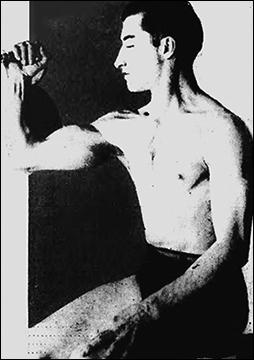 He has achieved so great success in the goal that he set for himself that he not only has overcome the handicaps which were in his path, but has built up his body until he is now a qualified physical culture instructor. He has achieved so great success in the goal that he set for himself that he not only has overcome the handicaps which were in his path, but has built up his body until he is now a qualified physical culture instructor.
Grube, 29, is manager of the Physical Culture studio at 509 South Salina Street. When he was 14, a schoolboy at Solvay High School, he suffered an attack of infantile paralysis which affected his spine in such a manner that he lost the use of his legs.
He was unable to leave his bed and spent his time reading. He became interested in the study of physical culture and was soon convinced that the path toward health lay in this direction.
He studied various methods and systems. But sheer willpower and a system of exercises, he managed to improve his condition to the point where he could leave his bed after two years.
He returned to school at Solvay. His condition made it impossible for him to enroll in the regular physical education courses, but he took special exercises under the direction of Earl Hadley, the instructor. Before he graduated, he was able to take his place in the regular class.
After graduation, his ailment continued to trouble him. He practiced devotedly at home, following various muscle-building exercises with some success.
Three years ago he decided that his career lay in physical culture. He went to the gymnasium then operated by Sam Kay, Greek exponent of physical education. He outlined his purpose to Kay and enlisted his cooperation in a plan where he was to have full use of the gymnasium in return for work he could do there.
His development was phenomenal. In two years his weight mounted from 127 pounds to 162. He increased his height by two inches and his muscles grew larger and as hard as iron. At the end of the two years he was an instructor in the gymnasium and was one of the models for the studio.
The ex-paralytic now goes through amazing feats on the bars, rings and trapeze. Muscles, which were once so weak that they could not support him when he wanted to stand upright, now easily respond as Grube demonstrates his weight-lifting powers.
He has set some excellent marks in the eight professional weightlifting maneuvers and has succeeded in lifting three tines his weight, 480 pounds of dead weight. He has equaled his weight with the two-hand military press, one of the most difficult of the “strong man” feats. He can raise 220 pounds with a two-hand press and 148 pounds with a right hand press.
Grube is satisfied he has found the path to health and happiness. All signs of the malady which felled him have disappeared and he is confident that he has defeated the paralysis forever. |
|
Ludwig Grube moved back to Solvay, married and had two children. For awhile he promoted wrestling matches in Syracuse and later opened Grube’s Bicycle and Hobby Shop. He was active in several community activities and in 1952 was the Democratic candidate for trustee, losing by one vote to Edward Donahue, 581-580, in one of Solvay’s most disputed and controversial elections. The result was protested, the Democrats attempting to disqualify a voter on grounds he was not a resident of Solvay, but the election was declared valid.
|
| |
Syracuse Journal, June 28
He hitch-hiked to history
CHICAGO — John Yezzi, 19, of Solvay, hitch-hiked to Chicago to attend the Democratic convention, making the trip in two days.
A student under Prof. Finlay G. Crawford at Syracuse University, Yezzi was winner of second prize in the Hearst essay contest last year.
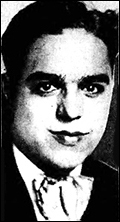 Yezzi (left) departed Solvay Sunday morning and had pretty good luck in picking the motorists to give him a lift. He reached Chicago last night about 5 o’clock and went to the YMCA. Yezzi (left) departed Solvay Sunday morning and had pretty good luck in picking the motorists to give him a lift. He reached Chicago last night about 5 o’clock and went to the YMCA.
During the evening he located Miss Frances Ryan, sister of Supervisor Julia Ryan, one of his former teachers. He also looked up Professor Crawford and obtained a ticket for the convention, where Franklin D. Roosevelt was nominated as the Democratic candidate for president.
The lad was pretty well tired out after his long trip and turned in early to get some rest before attending the convention today. He does not know how he will get back to Syracuse, but hopes the Syracuse delegation may help solve that problem. |
|
|
Mary Kass and Anne Marie Dwyer lead class
A class of 75 seniors received diplomas at Solvay High School on June 25. Mary K. Kasso was valedictorian and Anne Marie Dwyer salutatorian. |
| |
Syracuse Journal, August 5
He gives parents first airplane ride
Their first airplane ride was a long one for Mr. and Mrs. Mathew Speller of Jackson, Michigan, parents of Phil Speller of 105 Cogswell Avenue, Solvay.
Yesterday they flew from Jackson to Syracuse, with their son as their pilot, covering nearly 500 miles. both enjoyed the flight, although Mrs. Speller admitted she was afraid to look over the side of the airplane and Speller said he just kept hoping the motor wouldn’t stop.
Their son was making his first cross country flight since he obtained his pilot’s license three years ago. In Clayton Welch’s biplane he left Amboy early in the week and visited Cleveland and other cities before going to Jackson, where he talked his parents into flying back to Syracuse with him |
|
Tragically, Philip Speller, the pilot, would die in a plane crash in Canada in 1934 during a flight to pick up his wife, who was in Montreal. He also was survived by a four-year-old son, Philip J. Speller, who several years later became a doctor. |
| |
It's a wonder he survived
There was no follow-up to the next story, which usually means the injured party survived. If so, it's a wonder he did. This was the year's most spectacular accident within the village and attracted a huge crowd (photo, below), since it occurred so close to Milton Avenue, Solvay's main street, which intersects with Bridge Street. |
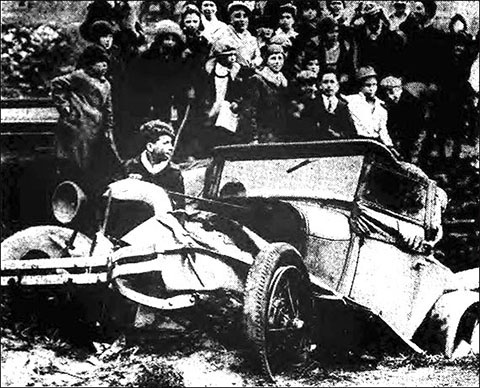 |
Syracuse American, April 3
Catapulted from his light roadster when it was struck and demolished by an eastbound passenger train at the Bridge Street crossing of the New York Central Railroad in Solvay yesterday afternoon, Earl Kennedy, 31, of Lakeland, is in critical condition today at the Hospital of the Good Shepherd.
Kennedy suffered possible skull fracture and numerous other hurts. X-ray examinations will be made at the hospital today to determine the full extent of his injuries.
According to Patrolman E. F. Kurtz of the Solvay police department, who witnessed the accident, Kennedy was driving north in Bridge Street. As he reached the tracks, the passenger train, in charge of Conductor W. R. O’Brien, roared into view. The cowcatcher of the locomotive caught the roadster broadside and tossed it into a small culvert at the side of the tracks.
The impact flung Kennedy from the wreckage and he was found lying a short distance away in a semi-conscious condition.
According to reports, John Yafancesco, flagman at the crossing, had received the block signal of the train’s approach and had just started to lower the crossing gates when the Kennedy car approached.
He did not have time, according to authorities, to shout a warning to the driver before the car was in the path of the locomotive. |
|
| Deaths |

Syracuse Journal, November 26
Petta stunt proves fatal
Stunting his light monoplane at an altitude of only 300 feet, John James Petta, 28, of 819 North Townsend Street, a student pilot, crashed to his death at Hayes Airport, Cicero, late yesterday afternoon when the plane stalled in a wingover and hurtled to the ground.
Petta was dead when pulled from the wreckage by Peter Harth of 721 First North Street, a pilot, and Jack Hines, a mechanic.
Both Harth and Hines witnessed the crash, as did R. H. Clement and Lieut. John Evans of 201 Melrose Avenue, new operators of Hayes Airport. 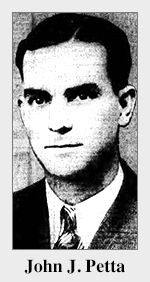 Clement and Evans were driving toward the airport when they saw the monoplane go over into a wingover, stall and plunge to the ground. Clement and Evans were driving toward the airport when they saw the monoplane go over into a wingover, stall and plunge to the ground.
The plane crashed on the airport within 200 feet of the Brewerton highway. Harth and Hines who were standing in the doorway of the hangar, ran to the scene and pulled Petta from the wreckage. he as dead. They notified state police and Coroner William R. Winne at North Syracuse.
Coroner Winne began an investigation immediately, with Trooper Andrews of North Syracuse and Deputy Sheriffs Ray Guilfoyle and Charles Otto. Asbury W. Meadows, department of commerce inspector, will comes to Syracuse, probably on Monday, to probe the crash for the federal government.
Clement told investigators that while driving on the outskirts of Cicero, he and Evans saw the plane stunting at a low altitude. Both remarked that the exhibition didn’t look so good and a minute later saw the ship plunge to the ground.
Harth and Hines said that Petta took off at about 4:05 o’clock after the former had started the motor of the plane for the pilot. The crash happened at about 4:45 o’clock. Petta’s watch stopped at that time.
Investigators learned from Harth that Petta did some straight flying and a few stunts at higher altitudes and then descended to about 300 feet where he attempted the wingover.
The plane, name the Phantom of the Clouds, is believed owned by Dick Lemon, former pilot for Robert Hayes at Hayes Airport. It is a two-place cabin monoplane.
So far as could be learned last night, Petta never obtained more than a student’s license. That was issued to him in July, 1931. He had more than 50 flying hours to his credit, however.
The victim, a former garage proprietor, gave up his business a year ago to continue flying. He was a race driving enthusiast, and had acted as mechanic for a number of drivers at various state fair races.
Yesterday’s fatality was the second at Hayes Airport in two years. Omer Messier, brother-in-law of Hayes, was fatally injured two years ago when the plane in which he was flying with Walter Buyea of Oneida, a student, crashed. Buyea recovered.
Petta his survived by his wife, Mrs. Lena Petta; his parents and four brothers, Don, Nicholas, Anthony and Michael Petta, all of Solvay.
|
|
Michael Petta owned a plane that in 1931 was seized by Royal Canadian Air Force officers. Petta was fined $100 for having contributed to a breach of Canadian air regulations as the plane was used in an attempt to fly a cargo of beer across the border into New York. Anthony "Tony" Petta was a featherweight boxer in the 1920 and '30s, with a record of 24 wins, 12 losses and 13 draws.
|
| |
Cedric S. Adams, 40, principal of Solvay High School and former World War aviator, died January 29 at his home, 106 Southview Road, Solvay. He was stricken ill December 30 with pneumo-coccus, a rare type of blood infection.
A native of Clinton, Mr. Adams was graduated from Hamilton College in 1912 and obtained his masters’ degree three years later. From 1912 to 1915 he served as principal of Newport High School. During the World War he enlisted in the aviation corps and was discharged with the rank of captain following a distinguished career overseas. At the close of the war he took charge of Wolcott High School and in 1924 became principal of the Solvay school.
|
Stricken while at work in the Solvay police headquarters, Horace Pettitt, village employee, died February 25 before medical assistance could be summoned. After an examination by Coroner W. R. Winne his body was removed to his home, 231 Caroline Avenue. Pettitt had been a resident of Solvay for 37 years and had been employed by the village for the past two decades.
|
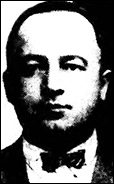 Abe Tarolli, 43, Solvay dry goods merchant for many years, died August 23 at Syracuse Memorial Hospital. He lives at 823 Woods Road. Abe Tarolli, 43, Solvay dry goods merchant for many years, died August 23 at Syracuse Memorial Hospital. He lives at 823 Woods Road.
A native of Tyrol, Italy, Mr. Tarolli was a resident of Solvay 30 years. He was a salesman for the Neal & Hyde Dry Goods Company for 10 years, opening a store in Solvay 16 years ago.
Mr. Tarolli was an honorary member of the Milton Athletic Club and was a member of Syracuse Lodge 31, BPOE, the Solvay Chamber of Commerce, Franz Joseph Society, International Society and the Solvay Tyrolian Brotherhood Club.
Surviving are a daughter, Miss Genevieve Tarolli; two brothers, Peter and Frank Tarolli of Solvay, and a sister Mrs. Mary Pizzini of Tyrol.
|
| Sports |
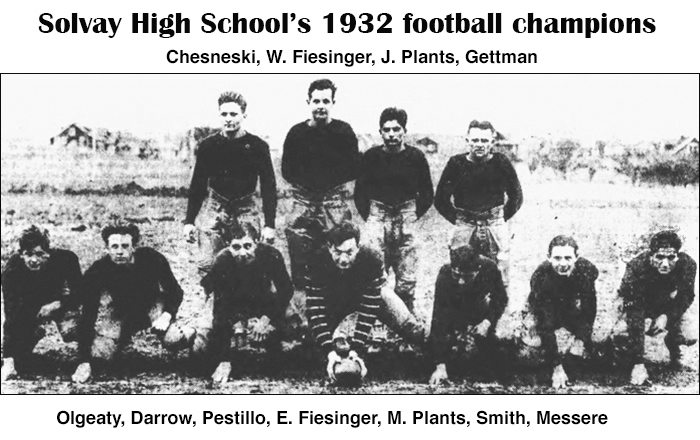
This time, a tie was as good as a win
Solvay High’s football team won its first five games, the fifth one being a 36-0 victory over North Syracuse on November 4. Touchdowns were scored by Olgeaty, Gettman, W. Fiesinger, Chesneski and J. Plants. Gettman kicked four extra points. Mescetti was credited with a safety in the second quarter.
Solvay players (and their positions) were listed in the Journal: Messere LE; Brostek LT; Mike Plants LG; Ed Fiesinger C; Pestillo RG; Darrow RT; Olgeaty RE; Joe Plant QB; Chesneski LH; Gettman RH; W. Fiesinger FB.
Substitutes: Smith LT; Sobey LG; Armani C; Hardisty RG; Louise RT; Pirro RE; Mescetti QB; Gozzi RH; Ghezzi FB; Bethka RG; Emlick LT; O’Leary FB.
On November 11 Solvay and Skaneateles met in the game that decided the league championship. Skaneateles also was undefeated, but had been held to a tie along the way. This game also wound up in a tie, 6-6, which gave the championship to Solvay. The Skaneateles touchdown was the only one given up by Solvay that fall. It came during the second period after Solvay had scored its touchdown on a 60-yard punt return by Gettman.
There was a wild finish to the game. Skaneateles drove to the Solvay four-yard line before they were stopped. Solvay then drove 93 yards to the Skaneateles three-yard line, but failed to score.
|
Other local football news . . .
It was a so-so season for the Solvay Tigers' football team, which won four game, lost four and played one tie. Tiger players include Brostek, DeStaffano, Yezzi, C. Sarno, Reale, Palladino, Pannetti, C. Louise, VanAlstyne, Lavingdale, Longley, Enwright, Kinnopa, Demperio, F. Sarno, Crivette and Bless. Again, some of these names are probably misspelled. Corrections can be sent through the contact information below.
The Tigers' biggest game was also their rowdiest. It was played on Roosevelt Field, Syracuse, on November 6 against a team called Meachem-Fenn, which emerged as the area's strongest semi-pro outfit that fall. Meachem-Fenn was ahead, 20-0, midway through the third period when an angry crowd invaded the field and would not leave. Officials ended the game on the spot. Leading the way for the winners was a man with a nickname you've got to love — "Squarehead" Clark, who tossed a pass to "Ruff" Stewart that resulted in a 92-yard touchdown. |
Basketball resumes . . .
Solvay High’s 1932-33 basketball team opened its season by beating North Syracuse, 40-19, and then embarrassed Nottingham of the City League, 32-8. However, on December 16, Baldwinsville upset the Bearcats, 22-21. It was the first loss for a Solvay basketball, football or baseball team since November, 1931, when the football team lost to East Syracuse, 6-0. Solvay then lost two straight non-league games, to St. Lucy’s and the Powelson Institute.
However, the Solvay rebounded and in March, 1933, would win the County League championship for the second season in a row. Players on the team included John Forken, John Brostek, Joe Bostek, Ronald Blair, Chuck Gettman, Flaherty and Olgeaty. |
Solvay team wins Sebo benefit game
While Solvay High School's victory over Split Rock High in March, which gave the Bearcats the Onondaga County League championship, was the most important basketball game of the year to most village sports fans, a December game featuring another Solvay team attracted more publicity.
That's because the game was played for a good cause — to benefit one of Syracuse University's best-loved athletes. Sammy Sebo apparently has been forgotten with time, but in the late 1920s and early '30s his name was well known in Central New York and his plight touched thousands of people who prayed for his recovery.
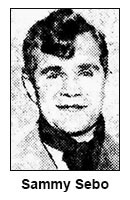 Sebo, a New Jersey native, was a three-sport athlete at Syracuse, but was particularly good at football. Though undersized, he played fullback and was known as a determined runner who was difficult to stop. An injury in his senior year against Nebraska — when he was kicked in the chest — would be cited as the beginning of the problem that led to his death four years later. Sebo, a New Jersey native, was a three-sport athlete at Syracuse, but was particularly good at football. Though undersized, he played fullback and was known as a determined runner who was difficult to stop. An injury in his senior year against Nebraska — when he was kicked in the chest — would be cited as the beginning of the problem that led to his death four years later.
It is unclear to me whether he was victim of tuberculosis or whether the football injury damaged his heart. In any event, after a brief career in professional football, he spent most of his last four years in treatment at a sanitorium in Saranac, New York, occasionally visiting Syracuse. Several events were held to raise money to pay for Sebo's care. One of those was a basketball game on December 21, 1932, between the Sacred Hearts of Syracuse and a team with an unusual name — Whippet Blue Blades, a brand of razor blade. The team formerly was known as the Solvay Polish-American Club, though clearly some of its players weren't Polish-Americans.
Sebo would die a year later. |
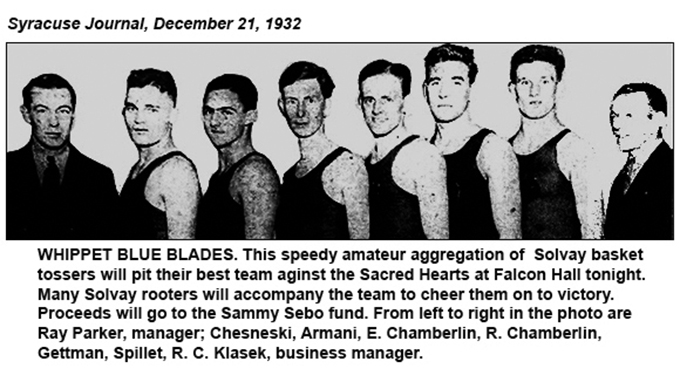
The game between those Whippets and the Sacred Hearts, it turned out better than anyone could have imagined, the Whippets winning, 28-26. It may be difficult for today's fans to imagine how exciting this game probably was to most of the people who witnessed it. After all, a total of 54 points in a basketball game that needed two overtime periods doesn't sound like much, but Syracuse University's Vic Hansen, one of the officials, called it the greatest basketball game he'd ever seen.
(Hansen, an All-American in both football and basketball, is the only man elected to both the college football Hall of Fame and the college basketball Hall of Fame. He also was head football coach at Syracuse for several years, but was fired because his teams were unable to beat Colgate. Until Jim Brown arrived, Hansen was considered by many to be the school's greatest all-around athlete.)
But back to the game, former Solvay High School star Dave Cohen led the Whippets with 14 points. As was common in those days, you'll notice Cohen missing from the photo above, because no doubt he was a bit of a ringer.
The teams did not meet again until March 31, 1933. This time the Sacred Heart emerged victorious — by one point, 32-31, at the Solvay High School court.
Five nights later they played again, this time for what was termed "the mythical state championship." Doubtless there were teams in other New York cities who had staked claims to the same title. Sacred Hearts won again, 30-27. "Ringer" Cohen did not play for the Whippets in either game.
Just the same — three games and two overtime periods played, and the teams were separated by just two points. |
| Also ... |
• The so-called basketball championship of the village was won by the Solvay Polish-Americans before they decided to call themselves the Whippet Blue Blades. That "championship" game was played in March when they humiliated the Solvay Tigers, 39-5. According to the short account of the game, these two teams had defeated every other club in the village.
|
• On May 21 Solvay's golf team lost to Baldwinsville, 12-0. Solvay golfers were Arthur Bieganowski, Victor Bieganowski, T. Moore and Ed Fiesenger. A year later the Solvay golf team would win the county championship. Two weeks earlier Solvay lost to Skaneateles, 8-4, in a golf match played in a pouring rain on the Liverpool course. |
• Solvay High’s boys’ archery team was given a scare by the Lincoln Green girls’ Archery Club on May 14, with Solvay winning, 612 to 610, though the outstanding archer of the day was Miriam Bruce, who scored 216 points, 41 better than Donald Orr of Solvay. Other Solvay archers were William Ingersoll, Bart Long and E. (Everett?) Lutzy. |
• Solvay High School's track team finished third behind Skaneateles and Baldwinsville inn the first Onondaga County Scholastic Track Meet on May 28t. Paussa of Solvay was second in the 100 and in the 220-yard dash. Kishman of Solvay was second in the mile run; Brostek of Solvay won the high jump and was tied for third in the pole vault, and won the shot-put. |
| • Solvay High School was represented in the first annual interscholastic tennis tournament, held in June. Solvay won no championships, but was well represented by six players — Bernard Conway, Ronald Blair, William Renders, George Flanagan Ray Mydlinski and Joe Mydlinski. |
| |
Most items are from the Syracuse Journal and its Sunday edition
the Herald-American.
|
| |
For more on Solvay way back when, check out
the Solvay-Geddes Historical Society |
| |
| HOME • CONTACT |
| |
|






 He has achieved so great success in the goal that he set for himself that he not only has overcome the handicaps which were in his path, but has built up his body until he is now a qualified physical culture instructor.
He has achieved so great success in the goal that he set for himself that he not only has overcome the handicaps which were in his path, but has built up his body until he is now a qualified physical culture instructor. Yezzi (left) departed Solvay Sunday morning and had pretty good luck in picking the motorists to give him a lift. He reached Chicago last night about 5 o’clock and went to the YMCA.
Yezzi (left) departed Solvay Sunday morning and had pretty good luck in picking the motorists to give him a lift. He reached Chicago last night about 5 o’clock and went to the YMCA. Clement and Evans were driving toward the airport when they saw the monoplane go over into a wingover, stall and plunge to the ground.
Clement and Evans were driving toward the airport when they saw the monoplane go over into a wingover, stall and plunge to the ground. Abe Tarolli, 43, Solvay dry goods merchant for many years, died August 23 at Syracuse Memorial Hospital. He lives at 823 Woods Road.
Abe Tarolli, 43, Solvay dry goods merchant for many years, died August 23 at Syracuse Memorial Hospital. He lives at 823 Woods Road. Sebo, a New Jersey native, was a three-sport athlete at Syracuse, but was particularly good at football. Though undersized, he played fullback and was known as a determined runner who was difficult to stop. An injury in his senior year against Nebraska — when he was kicked in the chest — would be cited as the beginning of the problem that led to his death four years later.
Sebo, a New Jersey native, was a three-sport athlete at Syracuse, but was particularly good at football. Though undersized, he played fullback and was known as a determined runner who was difficult to stop. An injury in his senior year against Nebraska — when he was kicked in the chest — would be cited as the beginning of the problem that led to his death four years later.